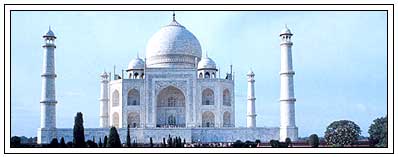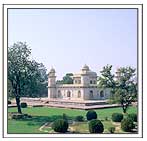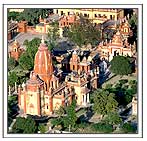Think Taj Mahal! Think Agra! The monument of ever lasting love. The Taj Mahal
undeniably takes center stage but there is a lot more to Agra. It is about
the grandeur, the splendour and the legendary people who crafted Agra as it
stands today. The relics of the bygone era, when the Moghuls ruled over this
city. Come join us as we take you on a date with the past. With luxury hotels,
shopping malls and plazas, wide avenues and a superb choice of venues for
recreation, business, sports, pleasure, education and the arts, the city aptly
emanates shades of modernity along with historicity. In short, it is an architect's
and historian's delight.

History
Agra has a rich historical background, which is amply evident from the numerous
historical monuments in and around the city. Though the heritage of Agra city
is linked with the Mughal dynasty, numerous other rulers also contributed
to the rich past of this city. Agra was founded by Sikandar Lodhi (Lodhi dynasty;
Delhi Sultanate) in the 16th century. Babur (founder of the Mughal dynasty)
also stayed for sometime in Agra and introduced the concept of square Persian-styled
gardens here. Emperor Akbar built the Agra fort; Jahangir beautified it with
palaces and gardens. Shahjahan marked the zenith of Mughal architecture, when
he built the Taj Mahal. The post-Mughal era of Agra saw the rule of the Jats,
Marathas and finally the British taking over the city.
What to see
Taj Mahal
The huge white marble monument built by Emperor Shah Jahan is in memory of
his beloved queen Mumtaz Mahal. It stands on the bank of river Yamuna. 20,000
workers have laboured for 17 years to build the mausoleum in 1633. The most
skilled architects, inlay craftsmen, calligraphers, stone-carvers and masons
came from all across India and lands as distant as Persia and Turkey. The
master mason was from Baghdad, an expert in building the double dome from
Persia, and an inlay specialist from Delhi.
The resulting work of architecture can be witnessed in its symmetry, balance
and exquisite inlay work
The beauty of the structure changes with the time of the day. Open 6 am to
7.30 pm from Saturday to Thursday
Agra Fort
Agra Fort, built under the Mughal Emperor Akbar in 1565, contains numerous
palaces and a whitemarble mosque. A sound and light show is conducted at Agra
Fort everyday after sundown. Open Sunrise to Sunset.
Itmad-Ud-Daulah
The monument in white marble standing across the river was built by empress
Noorjahan for her father Mirza Giyas Beg. Pietra dura inlay on marble was
first used here and the monument is believed to be a model for Taj Mahal.
Open sunrise to sunset.
Sikandara
The mausoleum of Emperor Akbar on the outskirts of the city (towards Delhi)
manifests his philosophy, piety and secular character. Open Sunrise to sunset
Chini Ka Rauza
Decorated with glazed tiles, it is an ideal example of influence of Persian
architecture on Mughal style. It is dedicated to poet-scholar and later the
Prime Minister of Shah Jahan, Allama Afzal Khal Mullah Shukrullah of Shiraz.
Chini Ka Rauza is a creation by Afzal Khan, who was a high official in the
court of Shah Jahan. Open sunrise to sunset.
Jama Masjid
Across the railway tracks from the Delhi Gate of Agra Fort, the Jama Masjid
was built by Shah Jahan in 1648. An inscription over the main gate indicates
that it was built in the name of Jahanara, Shah Jahan's daughter, who was
eventually imprisoned with Shah Jahan by Aurangzeb.
Ram Bagh
The Mughal love for nature can be seen at Agra in the form of Ram Bagh, one
of the earliest gardens, laid by the Mughal ruler Babur, in 1528 AD. It is
said to have been the resting-place of his body before it was taken away for
a final burial in Kabul. It is 2 to 3 km further north of the Chini Ka rauza
on the riverside and is open from sunrise to sunset.
Mehtab Bagh
Situated on the left bank of River Yamuna opposite Taj Mahal, it is basically
a garden to visit especially at Night. Central to the garden was an octagonal
pool that held the reflection of the Taj Mahal on a clear moonlit night, thus
originating the name.
Gateways
Fatepur Sikri
37 Kms from Agra
Fatehpur Sikri was the imperial city of the Mughal dynasty in the 14th century.
The deserted city has magnificent edifices and architectural grandeur. The
buildings within Fatehpur Sikri are a unique blend of different architectural
traditions reflecting the period of prosperity and social tolerance during
Emperor Akbar's administration.
There are a number of buildings within the Fatehpur Sikri complex. Each of
the small palaces in Fatehpur Sikri has a specific purpose and generally faces
a courtyard. The most intriguing building in Fatehpur Sikri is the Panch Mahal
(five-tiered palace), which is a five-storied pavilion of winds. The Turkish
Sultan’s palace is known for exquisitely carved panels depicting wildlife-lions,
birds, and foliage. Near the Diwan-I-Aam, one can see a tank called the Anup
Talao. Four bridges link the central platform at the Anup Talao. Here the
famous court musician Tansen played music. Akbar’s private apartments
stand close to the tank.
Vrindavan
57 Kms from Agra
Vrindavan is a sacred destination of the Hindus and is revered for of its
association with the life of Lord Krishna. There are as many as 4,000 temples
in Vrindavan, most of them dedicated to Lord Krishna, apart from the numerous
bathing ghats (long steps along the banks of sacred rivers, used by Hindus
for ritual bathing). Most of the temples in Vrindavan were constructed after
AD 1000, while some of them are of very recent origin.
Bharatpur (The Keoladeo Ghana National Park)
56 Kms from Agra
The Keoladeo Ghana National Park or the Bharatpur Bird Sanctuary lies between
Agra and Jaipur, in the state of Rajasthan.
Bharatpur hosts a variety of bird species from across the globe. Close to
380 species of birds are found in this 29 sq km stretch, approximately 10
sq km of which comprises of marshes and bogs. Rest of the area comprises of
scrublands, grasslands and more than 44,000 trees that are used for nesting
by birds each year.
Birds popularly spotted here include Siberian crane, Dalmatian pelicans, Siberian
leaf warbler, several other species of cranes-corcomorants, egrets, darters,
herons, storks, geese, ducks, eagles, hawks, shanks, stints, wagtails, wheatears,
flycatchers, buntings, larks, spoonbills, kingfishers, owls and pipits.
Mathura
47 Kms northwest of Agra
Mathura is famous as the birthplace of Lord Krishna, an important deity in
the Hindu religious pantheon. It is an important pilgrim place of the Hindus
and one of the seven sacred cities in India. Mathura is also an important
craft center.
The Sati Burj, Kans Qila, Jama Masjid and Dwarkadheesh temple are other places
to see in Mathura
Dholpur
34 kms south
The 11 century seat of a princely state on the banks of Chambal River. The
palace is now a luxury hotel and has a beautiful landscape. National highway
passes through the town and many express trains have a brief halt at the station
Shopping
Agra is not only a famous tourist destination but is a shopper’s paradise
too. There are plenty of shopping areas and shopping malls where one can buy
the specialities including handicrafts and fine arts traditions. You can shop
to your hearts content in the markets of the city and you will never get bored.
The old part of the city that includes the main marketplace (Kinari Bazar)
is northwest to the Agra fort. It has several distinct areas whose names are
attached with the Mughal period, although they don't always bear relation
to what is being sold here today. Like the Loha Mandi (Iron Market) and Sabzi
Mandi (Vegetable Market) are still operational, however the Nai ki Mandi (Barber's
Market) has attained the new role of a market famous for textiles.
The city is famous for its marble work. Hereditary craftsmen who are descendants
of the marble carvers, who worked on the 'Wonder in Marble' the Taj Mahal,
offer their wares in the crafts emporia and marble showrooms. A miniature
marble replica of the Taj Mahal, is a very popular souvenir, besides vases,
ornamental boxes, tabletops, decorative objects, utility items such as ashtrays
and table lamps. However, be cautious about the quality of stone. From shoes,
slippers, sandals, purses, wallets, bags, belts, clothing, lampshades, furniture,
beanbags, you name a craft in leather and the city has it for you. A leading
center of the footwear industry, you can find leather gloves, coats, jackets
and dresses, tanned in various colors and fashions to suit designer tastes.
When it comes to leather items , the city never fails to surprise the buyers
with its variety and quality. The rugs and carpets, woven by master craftsmen
who retain the secrets of carpet weaving taught generations ago by Persian
rug makers. The main markets for shopping for rugs and carpets are near the
Taj Mahal complex. These areas include Sadar Bazaar, Kinari Bazaar and Munro
Road. Brassware is another specialty of the city . It includes artifacts such
as hookah bases, for those who wish to acquire an oriental souvenir.
For quality buys visit: The U.P State Emporium called Gangotri at the Taj
Mahal Complex, offers a range of marble handicrafts.
The Shilpagram crafts village is another venue where marble items are on sale,
directly by the artisans themselves.
Visiting
Agra can be visited throughout the year, but one must avoid the extreme hot
summers (April-June) and rainy season (July-Sept). The most suitable time
to visit Agra is From Nov till March.
Tourist Offices
There are two tourist offices, one of UP tourism near Clarks Shiraz Hotel
(64 Taj Road, Ph: (0562) 360517) and the other of the Government of India
(191 The Mall, Ph: (0562) 363377). The government of India office has more
information on other destinations as well. There is also a tourist information
counter at the Agra Cantonment station.
How to get there
Air :Agra airport is 7 km from the city center and 3 km from Idgah
bus stand. Indian airlines operates daily tourist shuttle flights to Agra,
Khajuraho, Varanasi and back. It only takes 40 minutes from Delhi to Agra.
Rail Agra is well connected by railroad. The main railway station is
the Agra Cantonment station. Agra is well connected by rail to Delhi, Varanasi
and cities of Rajasthan.
Road Agra is 203 Km from Delhi Its 03 Hrs Drive away from Delhi.









